
History
Related to the intense development of Budapest in the late 19th century and for the benefit of the increasing number of reformed believers, the Church of Pest launched a national fund-raising for new church buildings. The first reformed church in Buda was started to be built in 1892 based on the "pentagonal" design by Samu Pecz. The church was consecrated on Palm Sunday in the year of the Millennium, 1896 by bishop Károly Szász.
Architectural chef-d'oeuvre
The gable-topped main nave is surrounded by four sanctum-like parts, with a central decagonal superstructure above them. The 62-meter high tower, the distinctive and highest tower on the Buda-side of the Danube, stands apart from the body of the church building. The spiry pyramidal roof, emerging from the squat body, is covered by multi-coloured Zsolnay tiles. In World War 2, the building stood in the forefront and suffered severe damages in the intense battles. The building is still under renovation.
The interior of the building has an astonishing and uplifting spatiality. Light arrives at the bright walls through high lanceted holes and rose-windows. The architect used the characteristic rules of neo-Gothic design as demanded by the liturgy of the reformed church. The interior is dominated by the pentagonal hub, with the Lord’s Table in the centre. The sanctum-like ‘naves’ are located on the sides of the pentagon, with various quotations from the four evangelists and Apostle Paul on the side-walls. Thus their practical distinction is easy: the gable-topped front-door nave displays two quotations from Apostle Paul so this is Nave Paul, while Naves Matthew, Mark, Luke and John come clockwise, with the latter giving place to the Elders’ Bench. The fixtures and furniture were also designed by Samu Pecz.
Getting to the church
The church is accessible
- by car: regulated and free parking is also available. However, the free parking places are usually engaged.
- by bicycle: the EuroVelo 6 European cycle route runs along the Danube.
- by public transportation: by bus #109 to Szilágyi Dezsõ square or by public transportation to Batthyány square and on foot from that.
Important: There is no pen in the cache, so bring your own! The hiding place is busy in the day time. Watch out for muggles!


Történelem
A fõváros 19. század végi nagyarányú fejlõdéséhez kapcsolódva, a növekvõ számú református hívõk érdekében a pesti egyház országos gyûjtést indított új templomok építése érdekében. 1892-ben Pecz Samu 'pentagon', ötszögû terve alapján kezdték meg az elsõ budai református templom építését. A millennium évében, 1896. virágvasárnapján szentelte fel Szász Károly püspök.
A templomépület - építészeti mûremek
Az oromzatos fõhajón négy, szentélyszerû rész fûzõdik körbe, melyek közül kiemelkedik a központi, tízszögû felépítmény. Az épület tömegétõl elválasztva áll a budai Dunapart városképének jellegzetes és legmagasabb tornya a maga 62 méterével. A zömök templomtestbõl kiemelkedõ csúcsos, gúla alakú tetõzetet többszínû Zsolnay cserepek fedik. A II. világháborúban frontvonalon állt a templomépület, amikor is súlyos sérüléseket kapott a heves harcokban. Felújítása jelenleg is tart.
A templom belseje meglepõ és felemelõ térhatású. Magas, csúcsíves nyílásokon és rózsaablakokon árad be a fény a világos falakra. Az építész a jellegzetes neogótikus szerkesztés szabályait a református liturgia igényeinek kielégítésére használta fel. A belsõ tér ötszögû központ köré szervezõdik, melynek középpontjában az Úr asztala áll. Az ötszög oldalain elhelyezkedõ szentélyszerû 'hajók' oldalfalain egy-egy evangélista és Pál apostol írásaiból olvashatunk különbözõ igéket. Így gyakorlati megkülönböztetésük is egyszerû: a fõbejárati, oromzatos hajóban két igét olvashatunk Pál apostoltól, így ez a 'Pál hajó', majd az óramutató járásával megegyezõ módon következik a Máté, Márk, Lukács és János hajó. A berendezések és a bútorzat is Pecz Samu tervei alapján készültek.
A templom megközelítése
A templom elérhetõ
- autóval: fizetõ és nem-fizetõ parkolás egyaránt rendelkezésre áll. Azonban a nem-fizetõ parkolóhelyek rendszerint foglaltak.
- kerékpárral: a nemzetközi EuroVelo 6 kerékpárút fut a Duna mentén.
- tömegközlekedéssel: a 109-es busszal a Szilágyi Dezsõ térig vagy tömegközlekedéssel a Batthyány térig és onnan gyalog.
Fontos: Nincs toll a ládában, ezért hozd magaddal a sajátodat! A rejtekhely forgalmas napközben. Vigyázz a muglikra!
